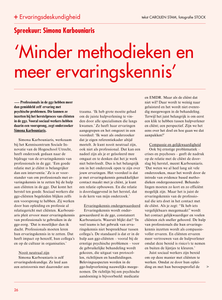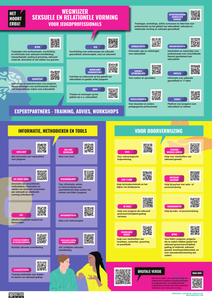Dit is een overzicht van methodieken, tools en handvatten om seksualiteit bespreekbaar te maken met jongeren.
DOCUMENT

NSVP - innovatiefinwerk.nl Auteurs: Daniel van Middelkoop, Gürkan Çelik, Ila Kasem, Lida van der Broek, Martha Meerman (red) Najat Bay, Olivia Andiel, Saskia Furrer Sonia Sjollema Samenvatting: Welke eisen stelt werken in een multiculturele omgeving aan professionals? Hoe kan integratie van arbeidsmigranten en vluchtelingen op een duurzame manier in organisaties plaatsvinden? Op welke manier kunnen ondernemers met een bi-culturele achtergrond hun innovatiekracht vergroten zodat ook de Nederlandse economie kan profiteren van de internationale netwerken die zij opbouwen? Het is een veelvoud van vragen op het snijvlak van organisatie en maatschappij waarvoor in de afgelopen jaren nieuwe methodieken zijn ontwikkeld, met financiële ondersteuning van de NSvP. Zo is een methodiek ontwikkeld om werkgevers te helpen om de kwaliteiten van vluchtelingen beter te onderkennen en te benutten, om het gesprek op gang te brengen om in onderwijs- en zorginstellingen de diversiteit in het primaire proces te begrijpen. Er is een project om jonge ondernemers met verschillende achtergronden meer met elkaar en met hun omgeving te verbinden. Het NSvP ondersteunde onderzoek naar Indiase verpleegkundigen die als arbeidsmigranten aan het werk gingen in een ziekenhuis. Het lijken allemaal zeer verschillende onderwerpen maar ze zijn allemaal gericht op het benutten van divers talent van werkende mensen.
DOCUMENT

Het streven naar een divers personeelsbestand behoort bij de retoriek die in menige organisatie wordt gebezigd, het in ogenschouw nemen van diverse perspectieven voor een goede besluitvorming eveneens. Alhoewel het debat over de gevolgen van diversiteit en het onderzoek naar het verschijnsel al decennia gaande zijn, wisselt de relevantie van het onderwerp sterk. Diversiteit staat op de agenda als de omgeving daartoe aanzet. Deze externe prikkels zorgen echter niet voor meer diversiteit op de werkvloer en dragen onvoldoende bij aan het op een hoger plan brengen van het diversiteitsonderzoek. Om verder te komen, is het nodig het roer radicaal om te gooien, aldus deskundigen op het gebied van diversiteitsonderzoek en praktijk die verenigd zijn in het expertise- centrum Nederlandse Stichting voor Psychotechniek (NSvP). In het artikel komen diverse methodieken aan bod, waaronder ook een coachingsmethodiek over crosscultureel ondernemen.
DOCUMENT

Professionals in de ggz hebben meer dan gemiddeld zelf ervaring met psychische problemen. Die kunnen ze inzetten bij het herstelproces van cliënten in de ggz. Vooral sociaal werkers hebben daarin een voorsprong, zegt onderzoeker Simona Karbouniaris
DOCUMENT

In het eerste deel van de tekst wordt het thema verkend: er bestaan veel verschillende, vaak karikaturale, beelden van onderwijsvernieuwing en veranderingsbekwaamheid van leraren, die een weerspiegeling zijn van de wijze waarop er wordt aangekeken tegen vernieuwingsprocessen in scholen en de rol van de leraar daarin. De visie op onderwijsvernieuwing is echter aan het verschuiven, waarbij er de laatste tijd meer ruimte komt voor de rol van de leraar. Onderwijsvernieuwing wordt steeds meer gezien als een leerprocesvan leraren binnen de context van de school als professionele leergemeenschap. Dat stelt eisen aan de interactie tussen de leraar, zijn leerlingen, collega’s binnen het team, de schoolleiding en de externe omgeving. Het eerste hoofdstuk sluit af met een reflectie over de kernelementen van onderwijsvernieuwing: zelfsturing, eigen verantwoordelijkheid en authentiek en samenwerkend leren.In het tweede hoofdstuk staat het begrip veranderingsbekwaamheid centraal. Dit leidt tot een werkdefinitie. Veranderingsbekwaamheid wordt gedefinieerd als een metacompetentie met betrekking tot het adequaat handelen in veranderingsprocessen, waarbij kennis, vaardigheden, houdingen, overtuigingen, identiteit en betrokkenheid worden ingezet. Die metacompetentie kan nader geoperationaliseerd worden door het beschrijven van kenmerkende situaties en van de onderliggende kennisbasis (in deze tekst breed gedefinieerd als de verzameling van kennis, vaardigheden, houdingen, over-tuigingen, identiteit en betrokkenheid die bijdragen aan veranderingsbekwaamheid). Het hoofdstuk sluit af met een eerste verkenning van de inhoud van die kennisbasis. In het derde hoofdstuk staat de vraag centraal hoe veranderingsbekwaamheid ontwikkeld kan worden. Aan de orde komen kenmerken van het (verborgen) curriculum, van het beoordelingssysteem en van de leeromgeving die veranderingsbekwaamheid stimuleren. Bij ‘leren veranderen’ gaat het niet alleen om leren over en reflecteren op de inhoud van de verandering, maar juist ook om het leren over en reflecteren op de aanpak van het veranderingsproces. In hoofdstuk vier worden vier instrumenten en methodieken beschreven die gebruikt kunnen worden om de veranderingsbekwaamheid van leraren te vergroten. Deze methodieken worden binnen de kenniskring ontwikkeld, uitgeprobeerd en geëvalueerd met individuele leraren en studenten en met teams. Het gaat om toepassing van NLP-methodieken bij individuele leraren en studenten, om reflecties op lopende veranderingsprocessen in een team, om het versterken van zelfsturing door lerarenteams en om het gebruik van toekomstscenario’s.
DOCUMENT

De NSvP ondersteunde de afgelopen jaren verschillende projecten op het terrein van culturele diversiteit. Martha Meerman (lector Hogeschool van Amsterdam) nam het initiatief om de verschillende projectleiders bij elkaar te brengen om de ontwikkelde inzichten in een breder kader te plaatsen. Waar liggen de raakvlakken, wat zijn overkoepelden inzichten en wat zijn de uitdagingen voor de toekomst? Het gesprek werd gevoerd door projectleiders met ruime ervaring met implementatie van diversiteitsprojecten: Sonia Sjollema, Ila Kasem, Lida van der Broek, Najat Bay, Daniel van Middelkoop, Olivia Andiel, Saskia Furrer, Gürkan Celik en Martha Meerman. De inzichten werden in een brochure samengevat. Interessant is het integrerende kader, waarmee de relationele aspecten van diversiteit in kaart worden gebracht. Afgesloten wordt met de plaatsing van het thema Diversiteit in de moderne organisatie context van flexibilisering en veranderende arbeidsrelaties. Wat zijn de relevante vragen voor de toekomst?
DOCUMENT
Dit is de sociale kaart seksuele en relationele vorming voor jeugdprofessionals. Een overzicht met informatie over methodieken en tools om aandacht te besteden aan seksualiteit en relaties, expertpartners op het gebied van training, advies en workshops en organisaties waar je naar kan doorverwijzen. De wegwijzer is een product voortkomend uit het onderzoeksproject Het hoort erbij! een samenwerking van Hogeschool Inholland, kennisinstellingen en jongerenwerk- en straathoekwerkorganisaties met het doel meer aandacht te hebben voor seksuele vorming in het jongerenwerk en straathoekwerk.
DOCUMENT

Full text via link. MBO Utrecht Academie Welzijn (niveau 3 en 4) en de Utrechtse buurtteamorganisatie Lokalis willen komen tot een samenhangende aanpak voor MBO-studenten met psychische problemen, gericht op inclusie en het voorkomen van uitval. Hiervoor is allereerst een gezamenlijke visie op de integrale begeleiding en ondersteuning van MBO-studenten met psychische problemen ontwikkeld, met de jongeren en ouders zelf, studieloopbaanbegeleiders en andere MBOmedewerkers, medewerkers van het Buurtteam MBO, en andere externe hulpverleners en betrokkenen. In deze visie worden de verschillende perspectieven (student, onderwijs, hulp en gemeente) in één conceptueel kader verenigd, als gemeenschappelijke basis voor een samenhangende aanpak.
LINK
Brotherhood is een beschrijving van een jongerenwerkmethodiek van het Stedelijk Jongerenwerk Amsterdam (SJA). De beschrijving van de methodiek is gerealiseerd door Youth Spot, een samenwerkingsverband tussen SJA en de Hogeschool van Amsterdam. Brotherhood wil het participatie- en integratieproces van vooral allochtone jongeren binnen de Nederlandse maatschappij bevorderen door de eigenwaarde van jongeren te versterken. Door samen sterk te staan maken de jongeren veranderingen in de samenleving zelf draaglijker en houden zij zich beter staande binnen de maatschappij.
DOCUMENT
Het streven naar een divers personeelsbestand behoort bij de retoriek die in menige organisatie wordt gebezigd, het in ogenschouw nemen van diverse perspectieven voor een goede besluitvorming eveneens. Alhoewel het debat over de gevolgen van diversiteit en het onderzoek naar het verschijnsel al decennia gaande zijn, wisselt de relevantie van het onderwerp sterk. Diversiteit staat op de agenda als de omgeving daartoe aanzet. Deze externe prikkels zorgen echter niet voor meer diversiteit op de werkvloer en dragen onvoldoende bij aan het op een hoger plan brengen van het diversiteitsonderzoek.
DOCUMENT